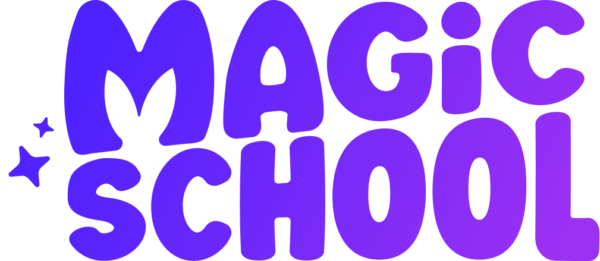One phrase that is guaranteed to send current educators into either terrified shakes or a vicious eyeroll is “AI in the Classroom.” I know, I know, you are likely exhausted of hearing about the highs and lows of AI. It has somehow infiltrated all parts of the cultural conversation. Unfortunately, the news is likely correct that AI is the future and we must adapt. For those who are wanting to gain a greater understanding of how exactly educators can work alongside AI, or even use it to their benefit, Magic School is a great starting point.
Magic School is a Generative AI Platform that contains a multitude of educational tools aimed at helping teachers. They claim to be a team of former teachers and principals who understand the pressure put on teachers to keep up with the demands that challenge them inside the classroom and out. Their mission statement is, “We’re here to help lighten the load, so teachers can save their energy for where they shine best—in the classroom, in front of students.” The tools they offer range from writing professional emails to generating lesson plans to creating teacher jokes. All of the many tools are simple, customizable, and made with teachers in mind.
For those who immediately take issue with any use of AI in the classroom, your concern is valid. I would encourage you to explore Magic School’s site and set of tools before you write it off completely. On their FAQ page, they discuss best practices for educators using the tool, such as checking for bias, not using student personal details, and the 80/20 rule of allowing AI to do the initial work then editing and adding the final 20%. The site has age limits and moderated content in place to keep students, who can also use the site, on the correct path.
For those with more questions about Magic School, I recommend Dr. Jennifer Parker’s review of the platform for the blog Tech & Learning. For those interested in how AI can be used in specifically historical work, I recommend Catherine Stier’s article on using ChatGPT for the National Council on Public History.

I wanted to test a couple of Magic School’s tools for myself and see how I could fit them into established lesson plans. The plans are for a 3000-level college class on Modern American History. The first tool I used was the Rubric Generator for an assignment where I have the students examine two selections from the US House of Representatives and Senate’s debates over the 2001 Patriot Act, then write a short essay comparing the narratives being told.

After simply filling in the prompt section and deciding it should be four sections, within seconds the site spit out a complete rubric. I then asked it to combine the “Organization and Coherence” and “Writing Mechanics” sections, to which it literally added the text together with no blending. While you cannot customize the rubric in Magic School, they do provide a few options to download or export the file so that you can make changes. I moved the rubric to a Word Document and was able to fully customize it to my specifications. I was incredibly impressed by the initial rubric it produced.

Another tool the site offers is the production of discussion questions based on whatever YouTube video you feed it. They do make the exception that the video must have captions on. For this example, I provided the link to Former Secretary of State Colin Powell’s 2003 address to the United Nations Security Council where he announced the US had evidence of Iraq containing weapons of mass destruction. In my lesson, I have the class watch this video and one of Powell in a 2011 interview with Al Jazeera where he backtracks his remarks. The students then break into pairs for a Think-Pair-Share discussion based on a set of provided questions.
While the questions are a bit robotic, I believe they could be an excellent starting point. It is interesting that they also provide the “answers” to the questions, along with the timecode where it is pulling it from.
I believe for educators dipping their toes into AI, Magic School is a viable opportunity. It does offer a free trial for 15 days where all of its paid tools are accessible. While the unpaid tools are okay, they certainly aren’t enough reason to use the site. Both of the tools I demonstrate in this post are paid tools. As long as AI is being used ethically with openness, it could be a major help to burnout and overwhelmed teachers struggling to meet state standards.
So how do you guys feel about AI? Would you being willing to use it in your classroom? Do you see any potential issues?


Emma, thank you for your insightful post about this teaching resource!
I have heard of Magic School but I have never used it myself. I was aware that there are growing AI resources for educators due to the age we live in. It is encouraging that this website acknowledges teachers’ concerns and offers recommendations on how to best implement AI in the classroom.
Your post was helpful and I appreciate your own experience you shared with creating a rubric. I believe I will give it a try myself!
I agree we must adapt to AI, to some degree. I would argue that we should strive to adapt it to us. Maybe this is a way to just make me feel a little safer in the scarry future of AI!
I absolutely have to try the discussion questions one!
I used this platform for making my rubrics for the summative assessments on my unit map. I found that it helped me to organize my ideas, yet I spent some time reworking what it produced. Honestly, the biggest help was how it generated the visual design of the rubric.
I’m still leery of AI, but this mix of auto-Generated and human-re-worked seems to be a good option right now.
Are you going to incorporate this in your unit on the War on Terror?
Hi Emma! I’m not going into education but I think a similar approach could be done in a museum setting. I attended an AI workshop on campus and the main benefit I saw of it was to use it as a brainstorming tool. I’ve found AI to be too vague to really be effective, but maybe asking questions of it to guide it somewhere more specific could fire those synapses to help the brainstorming process. I’m not a big fan of AI. It’s a fun tool to play around with, but I don’t like how it gathers information.
Hey Emma! As someone who isn’t going into education and highly skeptical about AI, I do think that AI can be a useful tool for providing general information and formatting, especially in a teaching setting. If teachers created this tool with the intention of helping other teachers, then I don’t see a major issue with it being used as a guide for lessons or rubrics, as long as a teacher can still be creative without using AI. AI work should still be proof-checked by a human in order to prevent errors.